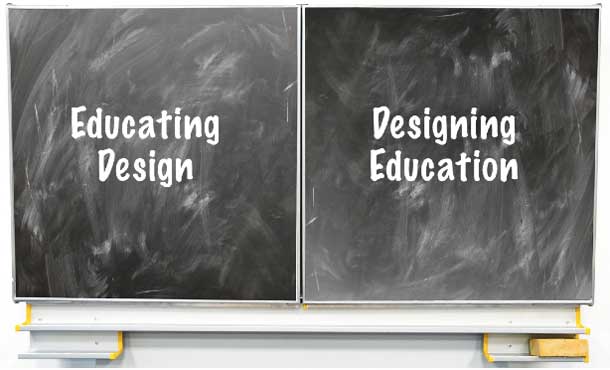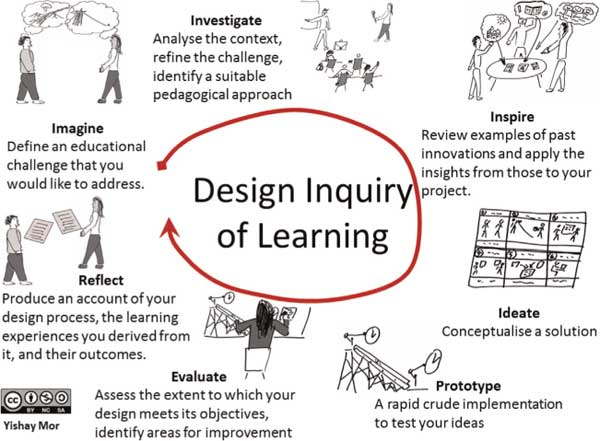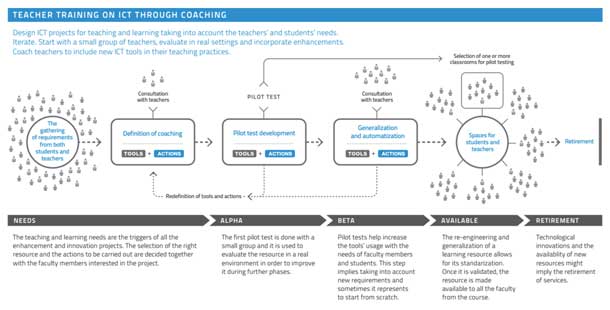
The concept of design in not new to education. However, the act of designing as we understand it in user experience—or design thinking—is not yet mainstream in the design for teaching and learning. The pervasiveness of technology and the maturity of both user-centered design and e-learning are intertwining design and education in deeper ways.
Until not long ago, all classroom settings were static and very much the same: a desk and a blackboard for the educator, books, papers, tables, and chairs for the students. Educators worked in a closed environment where it was enough for them to know their subject matter and how to teach it. Now, the ongoing introduction of technology in the classroom (audiovisual, computers, Internet access, tablets, and more) has led to many new elements and, therefore, the need to orchestrate them.
Modern design approaches and philosophies are well-placed to facilitate this orchestration. Designing education and educating design is the right path to take. While the immensity of the task can feel overwhelming, we as designers can find the challenge and beauty of it by tackling it at a human-sized level. Let’s not focus on the systemic problems and policy changes needed in education but on the things that we as designers can do to enhance the teaching and learning experience.
This crossroads of education and design is just the beginning.
From the Sage on the Stage to Interdisciplinary Collaboration
Nowadays, many educators agree that their role is to be a “guide on the side” as opposed to a “sage on the stage.” However, this mindset clashes with reality. Most educators are receive no training on how to be a guide, mentor, or coach. Too much emphasis is still placed on delivering hard facts. Most brick and mortar schools—and even many virtual classroom spaces—are designed to fit the lecture format. Educators are often on their own when preparing courses and lessons.
If we look at the case of open and distance universities, their intrinsic characteristics—avoiding the limitations of time and space—required the implementation of new teaching, and learning, approaches. These institutions were the first large universities to teach through channels other than the traditional classroom and thus had to find and adapt alternative ways and formats for distance teaching and learning. As a result, they adopted a design approach much earlier, with courses developed by teams of content experts, educational specialists, media technologists, and even typographical experts. Many open universities however, applied this multidisciplinary approach only to the development of learning materials—not to the technology they use in teaching and learning. This is an important drawback because technology-enhanced learning also needs to be designed.
The interdisciplinary approach implemented by open universities is an example of what educators need if we want education to move forward. In a world in which specialization and technology are increasingly embedded in our lives, educators should be able to collaborate more strongly with peers, learning technologists, user experience experts, and instructional designers for whatever skills and expertise that specific course requires.
This collaboration needs the right people but also relies on a specific mindset—a much less tangible requirement. With the tradition of the sage on the stage in our cultural heritage, many attempts at collaboration have failed.
If we look at how educational institutions are organized, most do not really understand how to incorporate these cross-cutting roles to enhance teaching and learning. Most institutions still work in silos with the instructional designers in one department, the learning technologists in another, the student support services in yet another, and the educators on their own. As we know, this type of organization hampers collaboration. Too often, these departments seem to be working for their own objectives as opposed to defining a shared set of objectives towards which all work together.
In the broader world of product development, on the other hand, we have design firms and design approaches where interdisciplinary collaboration is not only accepted but required. This is the kind of mindset that we need in education and why designers are needed to bridge these collaboration gaps and drive change in education.
Educators as Designers
There is an interesting paradox. When you think about it, it is obvious that educators are designers. They create courses, lessons, and activities by deliberately thinking about the what and the how. They design ways to integrate technology in the classroom, how to deal with a diverse target audience, how to assess their students, and so on. At the same time, most educators wouldn’t consider themselves designers, nor are they trained in design methods and processes.
In the field of education, learning design is a new discipline.. Quoting the title of the well-known book by Diana Laurillard, learning design researchers and practitioners acknowledge the fact that “teaching is a design science.” The pervasiveness of technology in our lives and its role in education has led to the development and growth of learning design. As almost all young disciplines, learning design is still finding its way at the practical level; in the meantime it has borrowed its processes and methods from user-centered design. The Design Inquiry Cycle as defined by Yishay Mor in the image below is an example of this:

Considering teachers as designers is a big move forward. It might seem a simple idea, but its implementation requires changes at many different levels of educational institutions. First, we need a stronger empowerment of educators. They should be in the driver’s seat and collaborate with a group of professionals that all share the same goals, that is, to place the learner at the center and provide him/her with the best learning experience. A learner-centered approach is also new in education; most often what drives the conceptualization of courses or lessons are the contents to be learned. Making the shift from the materials to the students will definitely have a positive impact in education.
[bluebox]
Principles for the Design Of the Learning Activity of A Subject
Changing the culture of any institution is hard work. When it is an education institution, you want to see two changes: the way projects are designed and developed and the way educators approach the creation of teaching and learning artifacts. This requires time and evangelization at many levels.
Inspired by the design principles developed by the UK GOV, we in the learning services department at the Open University of Catalonia (UOC) created ten principles to address the last goal.
- Start with the learning objectives. The competences and objectives which the student has to work on and achieve in the subject are the backbone in the design of the Learning Activity.
- Take context into account. The program typology, the subject characteristics, and the credits are also key in the design of the learning activity.
- Foster active learning. In other words, build the learning activity and not just the learning materials. The design of the learning activity will highlight the necessary resources and educational tools needed to achieve the objectives and competences of the subject.
- Take advantage of previous knowledge and resources. Reuse and adjust existing knowledge and resources. Be efficient and add value.
- Make it simple. Investing time in designing the learning activity gets a direct return: students with fewer doubts and more learning and satisfaction.
- Continuously improve. Use the students’ feedback and the learning analytics data to improve the learning activity—including tools and resources—in a gradual and continuous way.
- Think of everybody. Keep in mind the type of students, the variety of the learning contexts, and the diversity of technological devices when selecting resources and tools.
- Be consistent, not uniform. Choose tools and resources known by students. Likewise, select tools and resources according to the characteristics of the activity.
- Create open educational resources. Sharing the results with the society enriches us all and helps us to improve.
- Make it better.
[/bluebox]
The HANDSON MOOC as a Case Study
Massive Open Online Courses (MOOCs) have disrupted education not because of their intrinsic characteristics but because of the impact they have had in educational institutions, society, in the overall educational system, and even further. It is with MOOCs and mobile learning that e-learning has started to have a place in HCI/UX conferences and journals.
When I started drafting the HANDSON project (http://www.handsonict.eu/) I decided to jump into the bandwagon of MOOCs and benefit from it. The project team aimed at designing a continuous professional development activity for in-service educators—to empower them in how to integrate technology in their teaching and learning experiences. Our firm belief is that technology is an enabler, an integral part of what we use to reach our goals in education…but by no means the only tool. Therefore, we adapted the Design Inquiry Cycle to a 5-weeks MOOC during which educators followed a design process to conceptualize an Information and Computer Technology (ICT)-based learning activity.
MOOC participants had to enact a set of design activities that followed an almost classical design approach:
- Initiate – What is the educational challenge you want to address?
- Investigate – Who are your “personas” and their context?
- Inspire & ideate – Do a benchmarking analysis and define the user scenarios
- Prototype
- Evaluate and reflect – Define the heuristics of your project, evaluate your activity, and run a remote user test.
The HANDSON MOOC was run twice and was a meaningful experience for the educators who participated in it. They realized how often they start their design process with the learning materials as opposed to with the students. It helped them reconnect with why they were educators and gave them tools to center their design activities in their target audience and include ICT tools as part of the learning experience.
Participants had no problem with the steps of defining their personas, gaining awareness on their contexts, creating realistic user scenarios, and looking for similar learning activities. However, they stumbled with the concept of heuristics and evaluation in general. There is definitely work to do in this area if we want the full added value of design deployed in the field of education.
Designing for Teaching
Are educators only designers? From the perspective of a design professional in charge of, for example, designing a virtual classroom, educators are also users. Although there are many self-learning digital applications, most environments in education are mediated by an expert: an educator, a facilitator, a guide. Thus, when designing for learning we also need to consider designing for teaching.
This is where things get tricky. We have a double set of end users with different goals, needs, and characteristics. We have an end user that is, at the same time, a designer of the learning experience. As designers, educators need to be part of the design process. They are the subject experts. They are also the ones who know what they need that specific application for. As users, we need to understand their context and their characteristics.
We could consider them just as stakeholders. But then we would be losing their expertise, their validation, and their buy-in. It is the educator who will decide which tool to use and how and when to include it in a course. It is much better to incorporate them in the design process, from the requirements gathering, to the design iterations and evaluation. This is the approach we used at the learning services department of the UOC.
The trigger for any new project was the need of a small group of faculty members. We would then work with them to define the characteristics of the application and look for the best available solution, always looking first among open source alternatives. The faculty members would validate the tool selection and its adaptations and would then use it in their classrooms. User testing is adequate for evaluating the interface and functionality of an application, but when it comes to evaluating its impact on the learning experience, a real context is much more reliable. This is why—besides user testing—we would always run pilots with the students.
These pilots, which often lasted for a semester, allowed us to evaluate the usefulness and adequacy of the tool for both the teaching and learning experiences. Iteratively, semester after semester, we would make the required changes and increase the numbers of teachers and students that use the tool until the tool was generalized and available to everyone. The image below is a visualization of this process.
In this process, we had to keep the balance between designing for the specific need of a subset of the users and making the tool useful to a larger group of users. To accomplish this, we would rely on user testing with other faculty members and on accompanying the faculty members to use these new tools.

Moving Forward: An Increased Intertwining of Design and Education
Both examples cited in this article, the HANDSON MOOC and the learning services approach, show how UCD and UX can be applied in the design for learning. In the case of the HANDSON MOOC, we walked educators through a design process to conceptualize an ICT-based learning activity. In the case of the learning services department at the UOC, we implemented a user-centered design approach to update and innovate the teaching and learning tools of the Learning Management System (LMS).
Another element that both examples have in common is where the emphasis in the design process lies: in the learning activity, not the ICT tool. When we place the focus on the learning activity, we are acknowledging the teaching and learning ecosystem and can address the solution’s definition adequately. It is the learning activity that places the student at the center since we think of what the student will do and from there we define what artifacts and which processes are needed for him/her to accomplish this task.
Today’s ubiquitous learning means we learn anywhere, anytime, and from any device. Most digital tools can be used in education, making everyday activities part of the teaching and learning ecosystem. As designers, we can play a key role in the design of these ecosystems by, for example, applying service design methods and approaches.
Learning is both virtual and face-to-face, is multi-device by default, and happens at many different touch points. As designers, we need to understand and map the teaching and learning experiences. We need to understand that educators are also designers even if they do not have a formal training
The increasing complexity of our world calls for this need to intertwine expertise from a variety of disciplines. A single individual cannot master a subject matter, all available technologies for learning, the needs and characteristics of students, and all the other considerations that come with creating a learning experience.
As UX practitioners, we can bridge the gap between these disciplines through a collaborative design process. We can also empower educators to become better designers and deeply contribute to the innovation of education. This article briefly shows how user-centered design approaches can be implemented to define the philosophy and processes of educational institutions and how it can also be implemented to empower educators to design learning activities that use technology and enhance the teaching and learning experiences.
Full text from Figure 1: Design Inquiry of Learning
An iterative cycle of design inquiry:
- Imagine: define an educational challenge that you would like to address.
- Investigate: analyze the context, refine the challenge, identify a suitable pedagogical approach.
- Inspire: review examples of past innovations and apply the insights from those to your project.
- Ideate: conceptualize a solution.
- Prototype: a rapid crude implementation to test your ideas.
- Evaluate: assess the extent to which your design meets its objectives, identify areas for improvement.
- Reflect: produce an account of your design process, the learning experiences you derived from it, and their outcomes. Once you’ve done a first iteration, start again with step 1.
[/greybox]
Full text from Figure 2: Teacher Training on ICT through Coaching
Design ICT projects for teaching and learning taking into account the teachers’ and students’ needs.
Start with a small group of teachers, evaluate in real settings, and incorporate enhancements. Coach teachers to include new ICT tools in their teaching practices. The process is broken down into the following stages: needs, alpha, beta, available, retirement.
Needs: The teaching and learning needs are the triggers of all the enhancement and innovation projects. The selection of the right resource and the actions to be carried out are decided together with the faculty members interested in the project.
Activities:
- The gathering of requirements from both students and teachers
- Consultation with teachers
- Definition of coaching as tools + actions
Alpha: The first pilot test is done with a small group and is used to evaluate the resource in a real environment in order to improve it during further phases.
Activities:
- Pilot test development
- Possibly loop back to needs to redefine tools and actions
Beta: Pilot tests help increase the tools’ usage with the needs of faculty members and students. This step implies taking into account new requirements and sometimes it represents to start from scratch.
Activities:
- Consultation with teachers
- Generalization and automaticization
- Possibly loop back to needs to redefine tools and actions
Available: The re-engineering and generalization of a learning resource allows for its standardization. Once it is validated, the resource is made available to all the faculty from the course.
Activities:
- Spaces for students and teachers
Retirement: Technological innovations and the availability of new resources might imply the retirement of services.
[/greybox]
